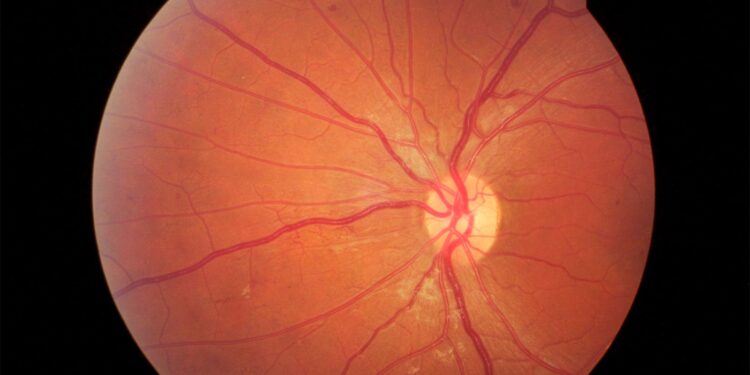[ad_1]
Use of empagliflozin (Jardiance) was not linked to a lower risk of incident nonproliferative diabetic retinopathy compared with dipeptidyl peptidase-4 (DPP-4) inhibitors among patients with type 2 diabetes, but the SGLT2 inhibitor was associated with a lower risk of diabetic retinopathy progression, an active-comparator cohort study suggested.
Among 34,239 matched pairs, the risk of incident nonproliferative diabetic retinopathy was not different between patients taking empagliflozin or DPP-4 inhibitors (HR 1.04, 95% CI 0.94-1.15) over a mean 8-month follow-up period, reported Elisabetta Patorno, MD, DrPH, of Brigham and Women’s Hospital and Harvard Medical School in Boston, and colleagues in JAMA Ophthalmology.
However, among 7,831 pairs, the risk of diabetic retinopathy progression was lower among those who initiated empagliflozin compared with the DPP-4 inhibitor group (HR 0.78, 95% CI 0.63-0.96).
The authors also found a lower risk of diabetic retinopathy progression with empagliflozin compared with SGLT2 inhibitor use overall, which “may be related to empagliflozin’s high selectivity,” they noted.
“Empagliflozin could be beneficial in slowing down progression to more advanced stages of diabetic retinopathy,” co-author Helen Tesfaye, PharmD, MSc, also of Brigham and Women’s Hospital and Harvard Medical School, told MedPage Today. “Prescribing decisions should be based on multiple factors including level of glucose control and patient factors such as cardiovascular and kidney disease.”
Empagliflozin is FDA approved for the treatment of heart failure, type 2 diabetes, and chronic kidney disease. It is not FDA approved to prevent or slow diabetic retinopathy.
Prior research has linked SGLT2 inhibitors, including empagliflozin, to a lower risk of diabetic retinopathy. The authors launched this study to learn more about a possible connection, Tesfaye said.
“To our knowledge, this is the first study to evaluate diabetic retinopathy progression using data generated from clinical practice,” she noted.
As for how empagliflozin might have a beneficial impact on diabetic retinopathy, “from previous studies, we know that SGLT2 receptors are expressed in the retina, and we speculate that inhibiting those receptors in the setting of high blood glucose might prevent damage to the retina,” Tesfaye explained. “Empagliflozin may also confer additional benefit through better control of blood pressure and glucose, which are known risk factors for developing retinopathy and progression to advanced disease.”
However, in an accompanying commentary, Jonathan E. Shaw, MD, and Alicia J. Jenkins, MD, of Baker Heart and Diabetes Institute in Melbourne, Australia, noted that the study’s findings may be misleading.
Some patients in the DPP-4 inhibitor arm may have turned to third- or fourth-line drugs such as insulin and GLP-1 receptor agonists, they wrote, which are linked to early worsening of diabetic retinopathy. “Thus, the apparent benefit of empagliflozin might have actually resulted from harms in the comparator arm.”
In addition, they pointed out that the short follow-up time “also adds uncertainty.”
Still, the study “raises the real possibility that SGLT2 inhibitors might slow the progression of [diabetic retinopathy],” and is worth investigating further, they concluded.
Patorno and colleagues noted that while ophthalmologists aren’t always comfortable prescribing systemic drugs like empagliflozin and the cholesterol drug fenofibrate, which has also been linked to slower progression of diabetic retinopathy, “as the evidence continues to grow for such agents, this will need to change.”
For this study, the authors used U.S. insurance claims data from two commercial insurers and Medicare from August 2014 to September 2019. They included adults with type 2 diabetes initiating study drugs without prior diagnosis or treatment for proliferative diabetic retinopathy or other advanced retinal diseases.
For the incident nonproliferative diabetic retinopathy analysis, the researchers tracked 34,239 propensity score-matched patients (mean age 65.6, 52.4% men, 75% white). For the diabetic retinopathy progression analysis, they tracked 7,831 matched patients with a history of nonproliferative diabetic retinopathy (mean age 67, 52.5% men, 68% white).
Incident nonproliferative diabetic retinopathy was defined using diagnostic codes for mild, moderate, or severe disease. The diabetic retinopathy progression outcome was defined as a composite of incident proliferative diabetic retinopathy, vitreous hemorrhage, initiation of intravitreal anti-vascular endothelial growth factor injection, or panretinal photocoagulation.
The authors noted limitations to their study, such as the short follow-up period and possible confounding and outcome misclassification.
Disclosures
This study was supported by a research grant from Boehringer Ingelheim to Brigham and Women’s Hospital.
Patorno reported receiving grants from Boehringer Ingelheim, the National Institute of Diabetes and Digestive and Kidney Diseases, the Patient-Centered Outcomes Research Institute, and the FDA.
Tesfaye reported receiving grants from Boehringer Ingelheim.
Co-authors reported relationships with Boehringer International, Eli Lilly and Company, and Novo Nordisk.
Shaw reported receiving honoraria for advisory boards and lectures from GSK, AstraZeneca, Sanofi, Novo Nordisk, Eli Lilly, Roche, Abbott, Boehringer Ingelheim, and Zuellig.
Jenkins reported receiving honoraria for advisory boards and/or lectures from GSK, Abbott, and CSL, and peer-reviewed research grant support from Medtronic and Abbott.
Primary Source
JAMA Ophthalmology
Source Reference: Tesfaye H, et al “Empagliflozin and the risk of retinopathy in patients with type 2 diabetes” JAMA Ophthalmol 2024; DOI: 10.1001/jamaophthalmol.2024.5219.
Secondary Source
JAMA Ophthalmology
Source Reference: Shaw JE, Jenkins AJ “Diabetic retinopathy — another possible target for SGLT2 inhibitors?” JAMA Ophthalmol 2024; DOI: 10.1001/jamaophthalmol.2024.5364.
[ad_2]
Source link : https://www.medpagetoday.com/ophthalmology/generalophthalmology/113230
Author :
Publish date : 2024-12-05 17:13:49
Copyright for syndicated content belongs to the linked Source.


![author['full_name']](https://newshealth.biz/wp-content/uploads/2024/12/Empagliflozin-Linked-to-Lower-Risk-of-Diabetic-Retinopathy-Progression.jpg)